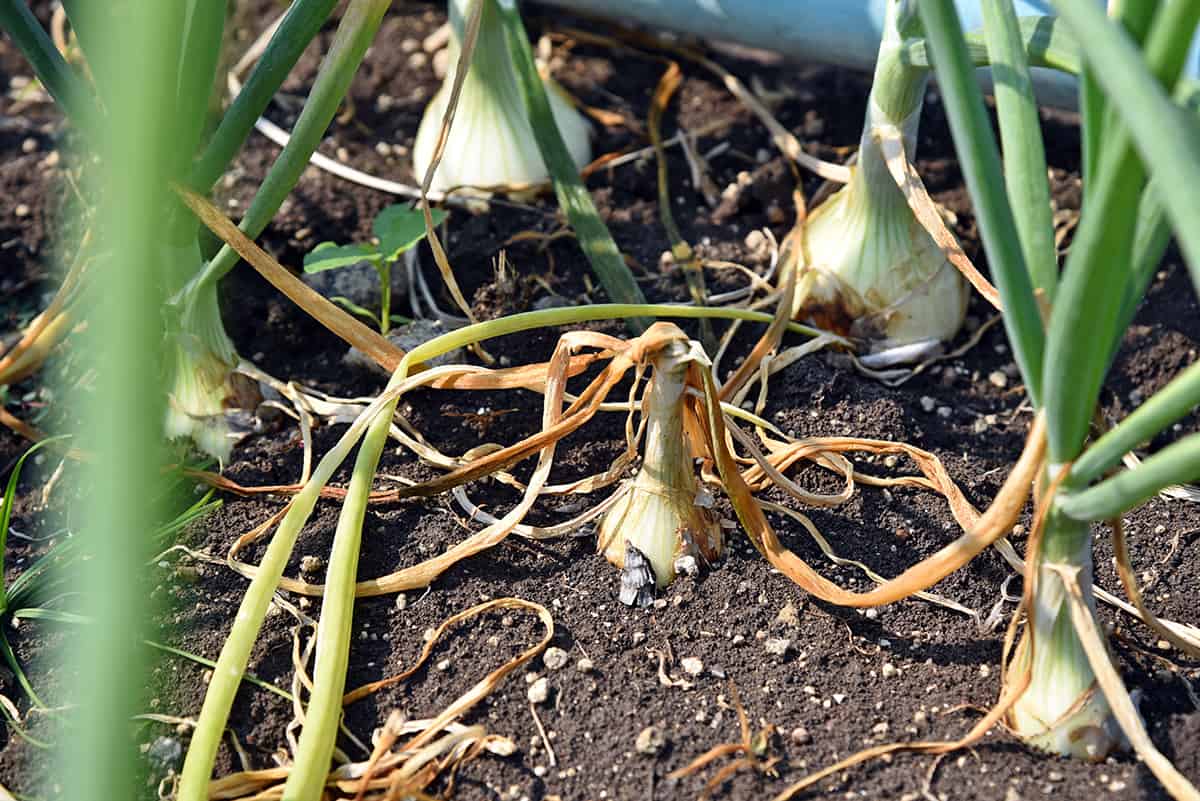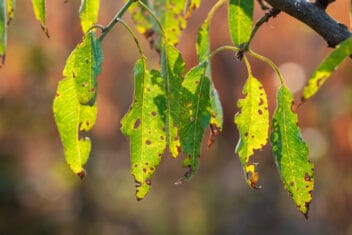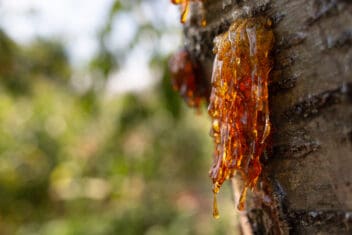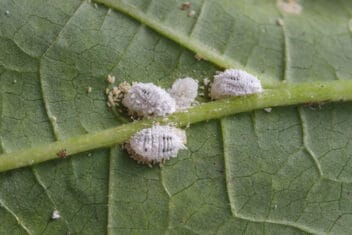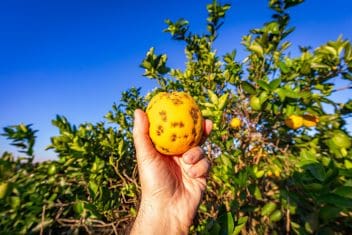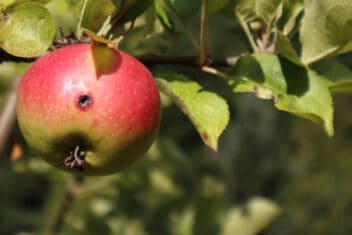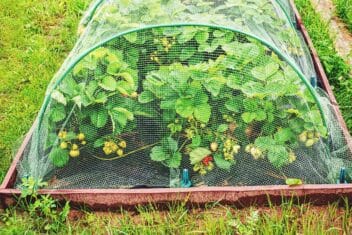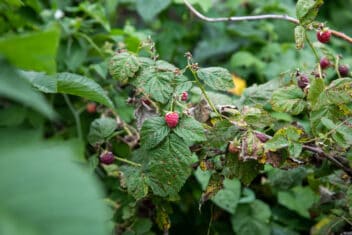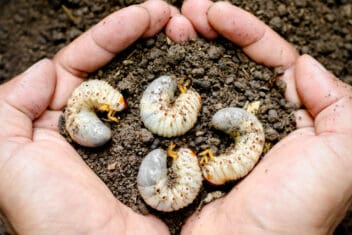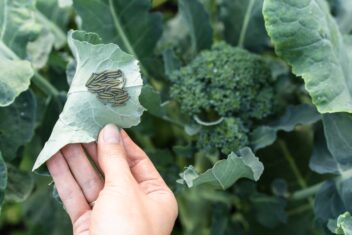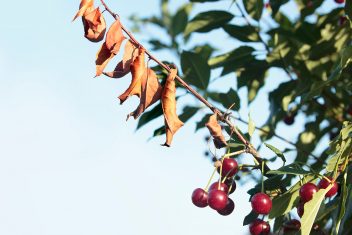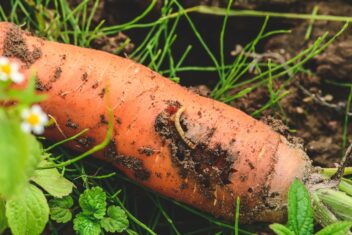If you plan to grow onions, you’ll likely deal with onion pests and diseases at some point. You may be lucky and have some very successful years, but they’ll likely be followed by a crop of fuzzy, slimy, or buggy bulbs.
Read on to discover some of the most common insects, blights, and fungal issues that may plague your onions (and other plants in the allium fam). And of course, we’ll show you how to deal with them if and when they appear.
Common Onion Pests (and Repellents)
Although alliums tend to repel many insects and pathogens, some stubborn species do like them an awful lot. Here are some of the jerks you may encounter, and how to contend with them.
Spider Mites
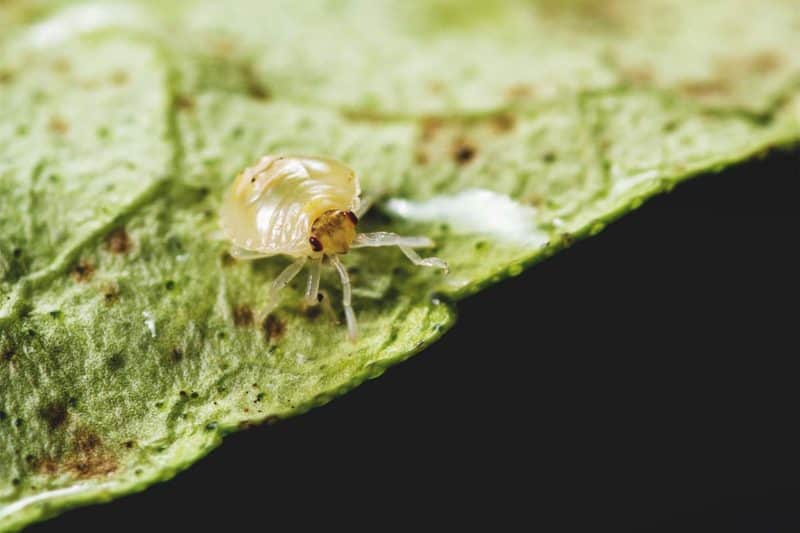
Oh, these guys. You know, generally, alliums are planted to repel spider mites. But there’s a species that actually likes them. The two-spotted spider mite — also known as the red mite — is ridiculously fond of onions. Plant cilantro around your onions to help fend them off, and treat infected plants with neem oil.
Bulb Mites
These mites are less than 1 mm long and cause pretty significant damage to bulbs during the growing process. While there’s no way of treating them once they show up, you can try to prevent them.
Rotate your crops regularly, so you don’t plant onions in the same spot two years in a row. Aim for a 5–6 year rotation gap. Also, avoid planting large groups of onions together. Use intercropping and companion planting methods throughout your garden(s) instead.
Thrips
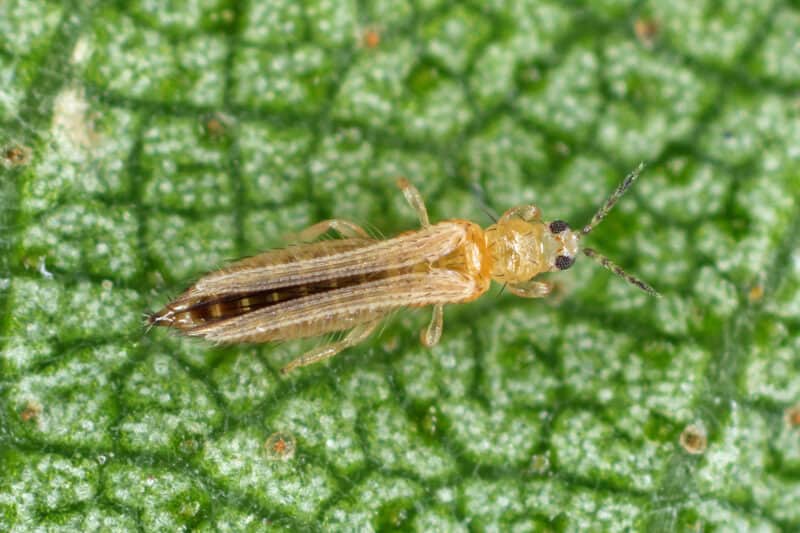
Are your onion leaves transparent and silvery? If they are, there’s a good chance you’re dealing with thrips. You can treat these with various insecticides, but once again, prevention is better than a cure. Avoid planting your onions anywhere near grains, as grain plants draw and encourage the insects.
Onion Flies/Maggots
Did you know that onions can get maggots? I didn’t until I found some in one of my beloved bulbs and ended up swearing in several different languages. These flies lay their eggs at the base of an onion. When the eggs hatch, the maggots burrow into the bulbs and eat their way through them as they mature.
The only way to prevent this from happening is to cover your young onion seedlings with agricultural fleece. If you dig up any maggoty onions, burn them to stop the cycle from reoccurring.
Leaf Miners
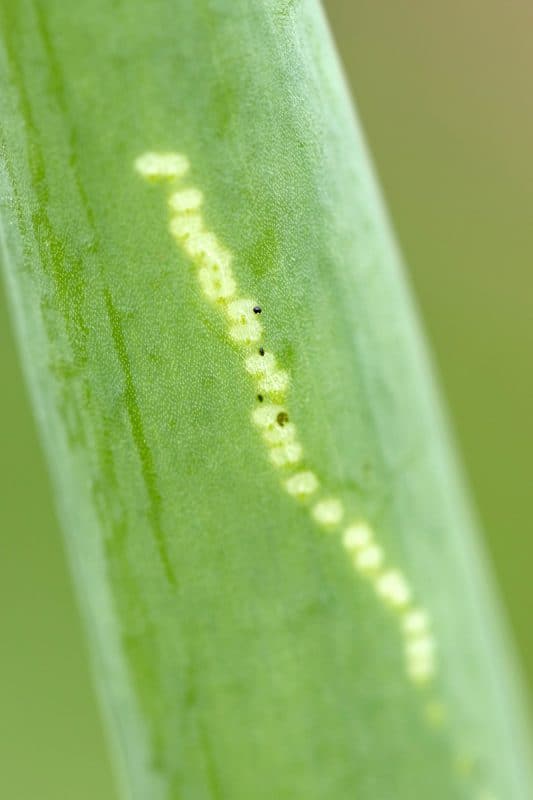
These assbutts devour pretty much any plant they land on. They leave pale, winding trails behind themselves: evidence of where they’ve munched their way over your plants. Remove afflicted leaves as soon as you find them, and burn them. Spray nearby plants with neem oil, and use floating row covers to prevent any more eggs from being laid on your plants.
Oh, and till your soil thoroughly in the autumn to chuck out the pupae snoozing in the earth.
Onion Diseases You May Encounter, and How to Deal with Them
All plants are prone to various health issues. Then again, what life form isn’t? Onions are quite hardy but can also suffer from many different diseases and pathogens. Below are the most common ones you might encounter and ways to counteract and heal them.
Damping-Off Disease
This is an issue you may encounter when you start your seedlings. It’s common when onions are planted outdoors too early and are exposed to cold, damp conditions. You can’t fix this once it sets in, but you can try to prevent it from happening.
Start your seeds in a soil-less starting medium, such as perlite or vermiculite and coconut coir. If you do start them in soil, make sure it’s a well-aerated potting mix. Avoid any soil that can be easily compacted, and only hydrate the seeds with warm water.
Additionally, you can try treating the seeds with a fungicide before planting. You can either look for commercial fungicides that contain metalaxyl or mefexonam, or slosh your seeds around in some diluted apple cider vinegar before planting.
Onion White Rot

As far as onion pests and diseases go, Sclerotium cepivorum is one of the most insidious. This fungal disease can lurk in your soil for up to 20 years! It’s devastating to all allium crops and is responsible for crop failures worldwide. You can identify it by the fluffy white fungal growth around the bulb bases and stalks, as well as wilted, yellow leaves.
There’s no real treatment for this issue. Your only option is to destroy the crop, dig out the soil and treat it with hardcore fungicide and solarization, and avoid planting any alliums there for at least two decades. When you decide to try planting onions again, try to find rot-resistant varieties and soak the seeds in warm water before planting.
Fusarium Basal Plate Rot
This fungal disease manifests as yellowed, curled, necrotic leaves and brown, mushy bulbs. The fungus thrives in warm, damp conditions and doesn’t have a cure.
Prevention is best, once again. Make sure to plant in well-draining soil and rotate the area with non-allium crops for at least 5 years between onion plantings. You can also try planting fusarium-resistant varieties if you can find them.
Black Mold
Although black mold can grow on onions during the maturation process, it appears more often when the onions are stored. The symptoms hold true to its name: you’ll see black splotches around the onion’s neck, and it’ll spread into blackened/brownish, watery flesh in the bulb’s center. Avoid storing your bulbs in damp, warm conditions to prevent this stuff from appearing.
Downy Mildew
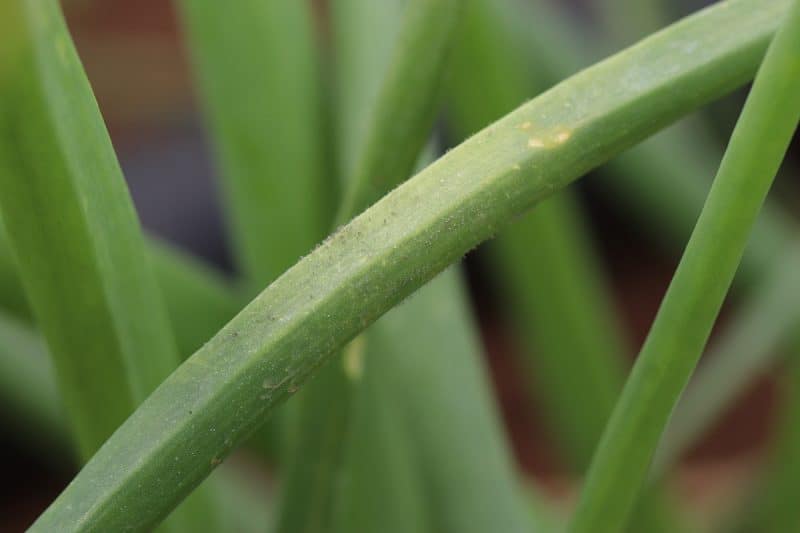
You’ve undoubtedly seen this one on several species before. It sort of looks like the fuzzy coating on one’s tongue after a week-long bender.
Powdery mildew is a fungal issue caused by the festive combination of wet foliage and cool temperatures. It also likes to hide in soil for long periods of time. You can treat both the soil and plants with organic fungicides and avoid the issue by watering at the soil level rather than overhead. Oh, and rotate crops regularly (noticing a trend?).
Purple Blotch
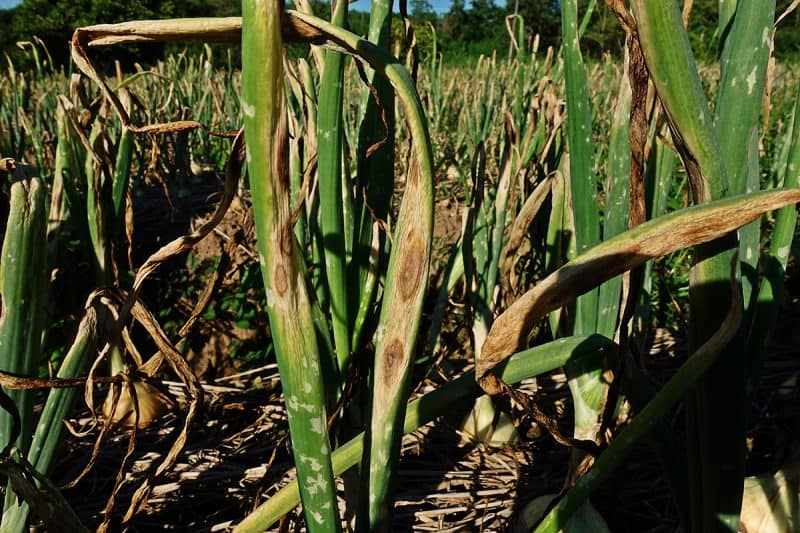
This fungal issue is quite self-explanatory, as it causes purple blotches to appear on your onions’ stems. It’s common in areas that get a lot of humidity and high rainfall.
There’s no treatment for it, so if you live in a hot, wet climate, try to plant your onions in well-draining soil. Make sure there’s plenty of space between plants, and eliminate any dead or decaying leaf matter.
Smut
If your leeks or green onions have ever looked curled and twisted, they’re likely stricken with smut. This fungal disease can also cause lesions filled with powdery-looking black “bleh.” There’s no cure for it: just destroy the onions and sterilize the soil.
The pathogen can stay in that area for years, so don’t plant onions anywhere near there again.
Yellow Onion Dwarf
Are your onions undersized, with yellow leaves? Then you’re probably dealing with yellow onion dwarf disease. Like many other onion pests and diseases listed here, there isn’t a “cure” for it, per se. Try to find disease-resistant seeds whenever possible, and disperse your onions throughout your garden.
Rust
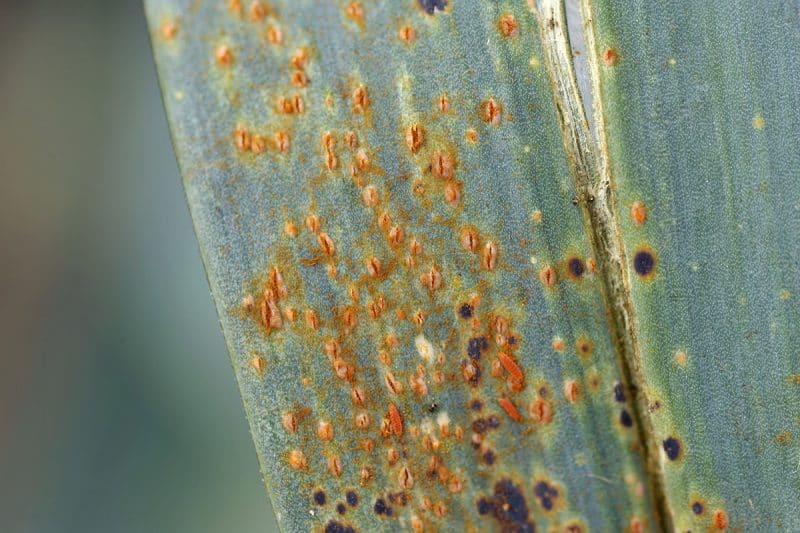
Do your onion leaves look like they’re as rusted as that truck chassis in your neighbor’s yard? Yeah, that’s rust rot. It thrives in warm, humid conditions where there isn’t a lot of rainfall.
There’s no way to treat it once it appears, so it’s best to try and avoid it. Make sure to plant your onions in well-draining soil, with plenty of space between them. Rust can’t survive on dead plants, so clear away fallen leaves, tall grasses, and any other plant detritus from your onions, leeks, and garlic.
Pink Root
Although this sounds like a festive, even fun sort of thing to discover, it isn’t. With pink root, the onion roots are indeed pink, and the bulbs are shriveled and undersized. This happens when you don’t rotate your crops! Let the area go fallow every few years, and be sure to solarize and then replenish the soil. Aim for at least 5 years gap between onion plantings.
Botrytis Rot
This only appears once the onions have been harvested and have been in storage for a while. It starts off at the onions’ necks or bottoms and creates a greyish, translucent discoloration throughout the bulb.
The way to prevent this is to ensure that you cut off all the onion roots and leaves when you harvest them. Then dry them out for a few days before putting them into cold, dry storage.
Other Potential Issues when Growing Onions
In addition to the aforementioned onion pests and diseases, you may have to contend with some other allium issues. For example, bolting is a pain in the backside but can happen with sudden heat waves.
There really isn’t any way to prevent an onion from bolting. If it’s gonna bolt, it’s gonna bolt. The only thing you can do at that point is quickly cut off the flowering stem. You’ll still be able to eat the bulb, but its flavor will be a bit different. You also won’t be able to store it long-term, as it will decompose quickly.
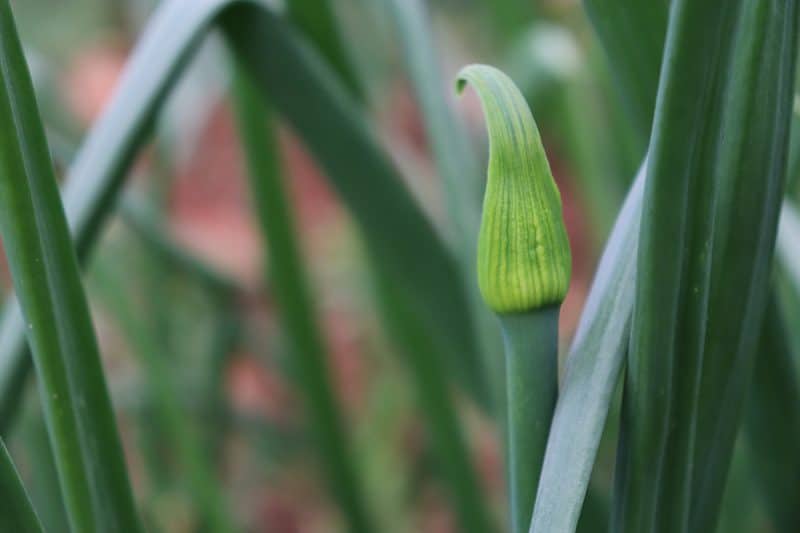
Try to harvest bolted bulbs and cook with them as quickly as possible. If a lot of them have bolted and you can only eat so many of them in one go, chop and freeze portions, or make onion syrup out of them.
Onions grown in groups tend to share diseases. To prevent this from happening, “socially distance” your onions. Do your research on companion planting to find out what other crops will benefit from alliums nearby. Plant them as perimeter plants to fend off deer and rabbits. Use them for edging fruit tree guilds, and plant them around your roses to fend off pests.
Most importantly, enjoy your harvest! There are so many onion species out there to enjoy, so diversify your garden and delight in every tasty morsel.
